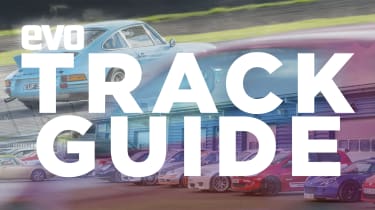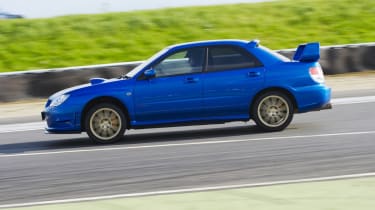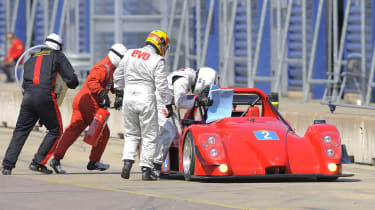Guide to your first track day
We explain how with a little preparation your first track day will be remembered for the right reasons
Taking to the track for the first time can be very nerve-wracking, you are, after all, taking yourself well outside your comfort zone and putting yourself into an alien environment. But a little preparation and knowledge go a long way and pretty soon you’ll be out there learning the full capabilities of your car and having a great time, too. Be warned, though, track driving is very addictive and once you’ve tried it, it’s hard not to want more.
> Book your next evo track day here
Choosing the right day
There are plenty of events held around the country every week, so finding a date won’t be an issue, but there are things to look out for. Firstly if you have a particularly noisy car you need to be careful to ensure you won’t exceed the set limit for the day. This limit will have been set by the local council and will be strictly enforced by the circuit rather than the trackday organizer, so if your car is too loud you won’t be allowed out on track, it’s as simple as that. As for location, we’d suggest choosing a circuit close to home so that your road driving is minimized, the concentration required for a full trackday can be quite tiring the first time, so it helps if you haven’t got to endure a long drive home afterwards.
Another thing to consider is whether you would prefer a day with running-in ‘sessions’ or one where an ‘open pitlane’ format is employed. ‘Sessions’ mean that you are given certain times when you can go on track – typically either twenty or thirty minutes long – and drivers of a similar speed and experience are grouped together in novice, intermediate and advanced sessions. This type of day is favoured by beginners as it ensures you won’t be out there alongside the experts, but you should check just how many cars are allowed at once to ensure it won’t be over crowded.
An ‘open pitlane’ day means just that, you can go out on track whenever you feel like (as long as the maximum number of cars on track has not been exceeded) and for as long as you like, so it gives the driver greater freedom as you’re not always checking your watch and waiting around. These days are sometimes more expensive as the number of cars that can be booked in by the organizer is lower. However, whichever type of day you book, you should check that the event has ARDS (Association of Race Driving Schools) qualified instructors on hand, as on your first day you should definitely hire one for a session of instruction. Generally this will cost £20-£30 for twenty minutes, but you will learn far more from then than you will by just driving around all day on your own.
Preparing the car
As long as the car is good condition there should be no major problems with using it on track. It’s advantageous if it has had a recent service but regardless of this you should ensure that the fluid levels are all up to their maximum mark (and it’s worth checking the oil a couple of times during the day) and tyre pressures should be set at the manufacturers recommended levels. There is often debate about this between drivers as to which is the best level for maximum grip but running the pressures too low can damage the sidewalls as they flex during sustained cornering, and as they will heat up on track (and therefore the pressure will rises) starting them too high can increase the wear rate. Inside the car you should ensure there are no lose objects that might fly around, and if you intend using a video camera it will have to be securely mounted and often you will need to sign a disclaimer form that states that the footage is for private use only.
If you drive smoothly and properly there won’t be a huge increase in wear rates but you should ensure there is a reasonable amount of tread depth left on the tyres, especially if you are driving the car home on the road. Always complete a cool down lap before coming into the pits to get some air to the brakes, engine and the transmission, and once in the pits at the end of a session do not apply the handbrake as the pads can weld themselves to the discs when hot. If you feel the brake pedal go ‘long’ when on track don’t panic or come straight in, do a cool down lap and you should find that once they have cooled a little the firmness under foot will return.
Insurance
Some road policies cover trackdays automatically, but most don’t. However you can usually add this for the day by calling them and paying a small premium. If this isn’t possible or preferable then there are companies who offer specific trackday cover and should you claim on them it will not affect your regular no claims discount.
Preparing yourself
This may sound obvious but ensure you sleep well to arrive fresh and you should keep yourself hydrated, particularly on a hot day. Most circuits insist that your arms and legs are covered inside the car (no shorts and T-shirts) and if you have some overalls and boots it makes sense to wear them. If not then we suggest a pair of thin-soled trainers to ensure you have good pedal feel. As regards a helmet, if you don’t have one most trackday companies will hire one to you (check and book in advance), but if you are going to do it regularly then it’s wise to invest in one. Motorbike helmets are allowed on trackdays but we suggest getting one that complies to motorsport standards, either open face or full-face. These will be more expensive, but they will be more comfortable and should the worse happen then they offer greater protection and are fireproof.
The day
Once booked you will receive your ‘final instructions’ which will cover all the rules and regulations for the day and inform you of the time when you can ‘sign on’. Arrive early so that you have plenty of time to find a pit garage (if the circuit has them), and get organized without rushing around worrying about everything. At sign-on you will be required to sign an indemnity form and then given a wristband and number sticker to put on the car, you will also be told where and when the mandatory briefing will take place.
> Track day fitness: how to train your mind and body for track driving
Everyone, regardless of experience has to attend the briefing (you are often issued with a second wristband to prove you’ve been there) as the trackday organizer will run through the format and timing of the day, along with the rules and flag signals.
The rules
The biggest rule always is the one concerning overtaking and almost always this is allowed only on the left-hand side and only on the straights and never in the braking zones (there are a few exceptions to this, Castle Coombe has a policy of overtaking on the right and some days organized for experienced drivers only do occasionally allow overtaking on both sides). This means that overtaking requires co-operation from both parties as the car in front has move over to the right (and sometimes lift-off a little) so that the following car can pass. This is what differentiates a trackday from testing and creates a safe environment where everyone can have fun. No one will dive down the inside of you under braking and once you reach the corner you can concentrate fully on it in the knowledge that anyone behind you will have to wait until you reach the next straight before you let them past. There are marshals all around the circuit so anyone transgressing this rule will be immediately be spotted and the driver will be hauled in to explain themselves.
>Track days: everything you need to know
Track day flag signals
These will be gone through in detail during the briefing and sometimes not all of them are used, but here are their meanings:
• Yellow - There is danger ahead. Slow to half speed and no overtaking is allowed until you have passed the incident, this maybe followed by a green flag to indicate all is now clear.• Red - There is danger ahead. Slow to half speed and no overtaking is allowed, but this time it refers to the whole circuit. You must also return to the pitlane immediately• Black - Return to the pitlane immediately and report to the organisers. There maybe something wrong with your car that you are not aware of or the ma need to chat to you about your drivingYellow and red stripes – Slippery surface. Be very careful there maybe oil or other fluid on the track• Blue - The overtaking flag. There is a faster car behind you wishing to overtake, move over when next on a straight• Chequered - End of session. Drive slowly round o the pits giving the car a chance to cool.

Find more on track cars, track days and track driving through the links below...





